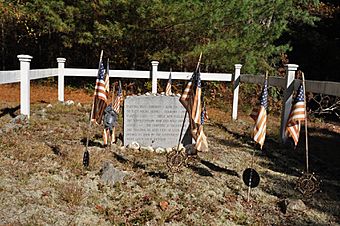Parting Ways (Plymouth, Massachusetts) facts for kids
Quick facts for kids |
|
|
Parting Ways Archeological District
|
|
 |
|
| Lua error in Module:Location_map at line 420: attempt to index field 'wikibase' (a nil value). | |
| Location | Plymouth, Massachusetts |
|---|---|
| NRHP reference No. | 79000367 |
| Added to NRHP | April 19, 1979 |
Parting Ways was a special community where African-American people who had been freed from slavery lived. It was located near what is now Route 80 in Plymouth, Massachusetts. You might also hear it called the Parting Ways Archeological District or the Parting Ways New Guinea Settlement.
This community started on about 94 acres (380,000 m²) of land. It was founded by four brave men who had been enslaved but then fought in the American Revolutionary War. Their names were Cato Howe, Prince Goodwin, Plato Turner, and Quamony Quash. After the war, the Massachusetts courts granted them their freedom because of their service. In 1792, the town of Plymouth made an agreement: anyone who could clear the land could claim it. These families worked hard to clear the land and make it their home. A part of this historic area was added to the National Register of Historic Places on April 19, 1979.
Contents
Discovering Parting Ways: An Archeological Dig
The Parting Ways site includes an old cemetery, places where people threw their trash (called middens), and the stone foundations of the families' homes. These foundations are what's left of the buildings after the rest has worn away.
What Did Archeologists Find?
In the mid-1970s, a team of archeologists explored this site. The team was led by Dr. James Deetz, who was a professor at Brown University and worked at Plimoth Plantation.
Dr. Deetz studied the items found at Parting Ways. He believed that African Americans living in the 1700s and early 1800s kept some of their unique African traditions. For example, he thought their houses were built in a special style called the shotgun house. He also noticed that they cut their meat by chopping through the bones, while their white neighbors used saws to cut across the bones.
Learning from the Past
Even though the evidence was limited, Dr. Deetz's work helped us understand how these freed families lived. It showed how they kept parts of their culture alive even after facing many challenges. Archeology helps us learn about people who lived long ago by studying the things they left behind.
Images for kids


